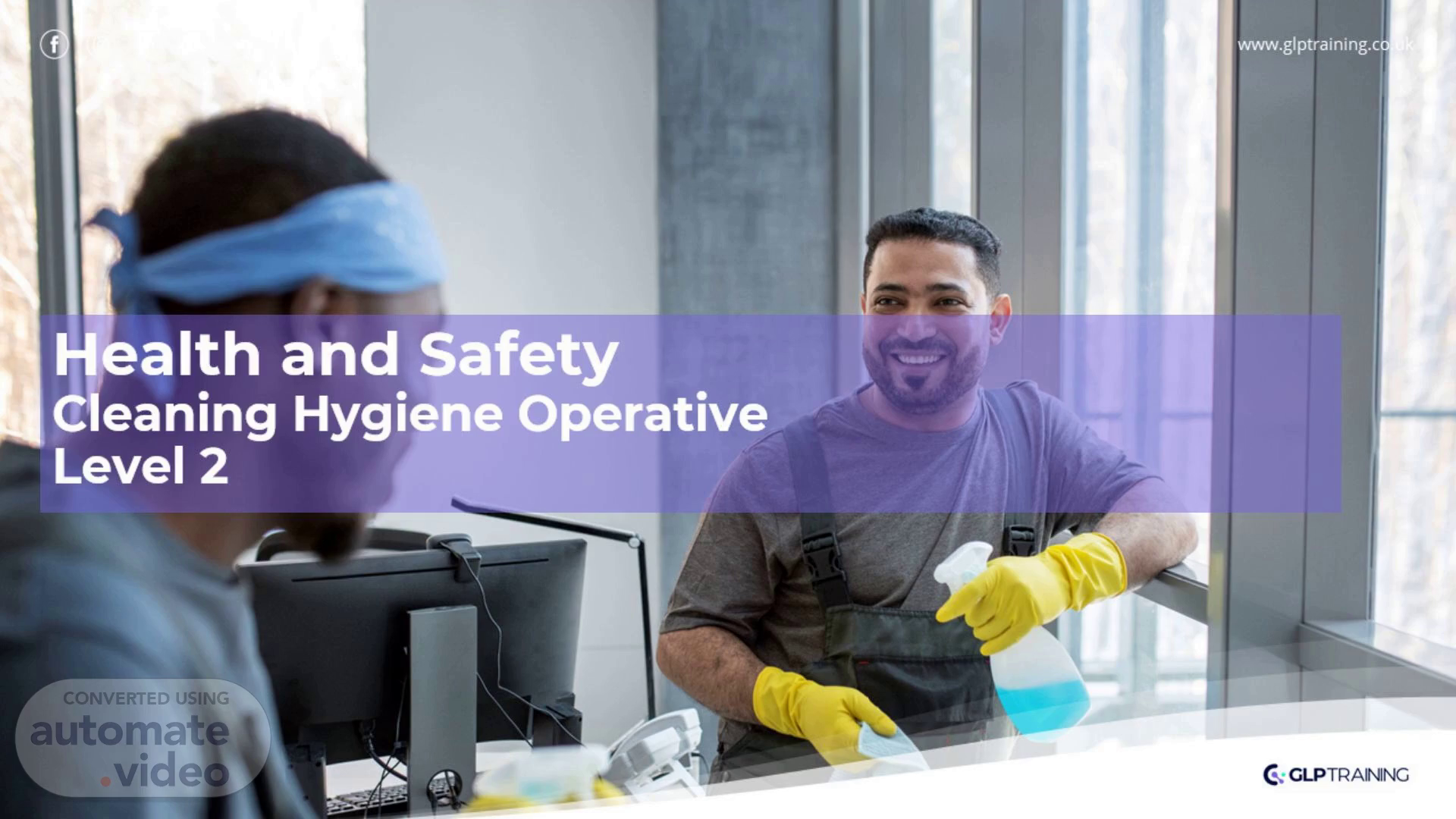
Page 1 (0s)
Health and Safety Cleaning Hygiene Operative Level 2.
Page 2 (6s)
Session outcomes. K1: Know how to manage risk and identify when there is a need for change from routine to enhanced cleaning protocols K19: Explain the principle of reporting shortages, incidents, accidents, and issues with delivering cleaning services. K22: Describe the principles of personal hygiene and PPE requirements in the workplace..
Page 3 (23s)
Health and Safety and cleaning. Why is Health and Safety important in cleaning?.
Page 4 (31s)
Moral. Risk Assessments. Objectives of a Risk Assessment The main objective of a risk assessment is to determine the safety measures required in order to protect people and plant but also to comply with legal duties. Moral Legal Financial.
Page 5 (49s)
Risk Assessments: All must be documented as a legal requirement if you employ 5 or more people.
Page 6 (1m 8s)
Risk assessment. Risk Assessments are about looking at Hazards that are present and defining the Risk associated with Hazards. So how do we identify Hazard and risk? How do we know what is an accident and what is an incident? Define Hazard Define Risk Define Accident Define Incident.
Page 7 (1m 23s)
Step 1. Identify the hazards. 7.
Page 8 (1m 33s)
Step 2: Identify who will be harmed and how. Look around the room. Based on your identified hazards, who could be harmed by them and how? Examples of who are: Yourself, your manager, other colleagues, the public? Examples include: Tripping over wires Slipping on spilt liquids Falling objects such as boxes.
Page 9 (1m 50s)
Step 3: Identify the risk. What is the risk of Jon falling over that computer wire and the severity of the consequences? An important aspect of risk assessment is identifying the likelihood of an accident occurring due to an identified hazard and the severity or seriousness of potential consequences..
Page 10 (2m 6s)
Step 3: Qualitative Risk Assessments. 10. 5 10 15 20 25 4 8 12 16 20 3 6 9 12 15 2 4 6 8 10 1 2 3 4 5.
Page 11 (2m 16s)
Step 4 record your findings. As with any Health and Safety requirement, you MUST record and document your findings. Your company will have its own forms but an example is below..
Page 12 (3m 3s)
Step 5: Review your assessment. It is vital to review your assessments on a regular basis. This is vital if an accident has occurred and part of accident investigation and is a requirement from the HSE. Changes in the workforce such as expectant or nursing mothers, young people or disabled workers need to be considered..
Page 13 (3m 21s)
Control measures. Once the assessment has been carried out we must prioritise and eliminate or reduce the risk. We have carried out the assessment and listed the hazards but what control measures would you put in place?.
Page 14 (3m 34s)
What is PPE?. Discuss what is PPE?. Personal Protective Equipment PPE stands for Personal Protective Equipment. It refers to specialized equipment or clothing designed to protect individuals from various hazards in the workplace or during activities where there may be exposure to potentially harmful substances or environments. PPE includes items such as gloves, helmets, goggles, masks, respirators, face shields, safety clothing, and other gear intended to minimize the risk of injury or illness. The use of PPE is crucial in many industries to ensure the safety and well-being of workers..
Page 15 (4m 0s)
What PPE would you use in cleaning?. Dust masks Guards on cleaning machines Safety googles Protective clothing Footwear Hearing protection.
Page 16 (4m 10s)
Hazard signs. Old Hazard Signs. 16. Explosive Compressed Gas Harmful Flammable Corrosive Health Hazard Oxidizing Toxic Environmental Hazard.
Page 17 (4m 22s)
Session outcomes. K1: Know how to manage risk and identify when there is a need for change from routine to enhanced cleaning protocols K19: Explain the principle of reporting shortages, incidents, accidents, and issues with delivering cleaning services. K22: Describe the principles of personal hygiene and PPE requirements in the workplace..
Page 18 (4m 39s)
Check your knowledge –Health & Safety.
Page 19 (4m 46s)
Assignment. Now complete a knowledge test to show your understanding of this topic (K1/K22) You will complete a mock observation and interview later in this course to show the following skills: K19: The principle of reporting shortages, incidents, accidents, and issues with delivering cleaning services. S3: Use and dispose of chemicals following COSHH regulations and apply safety data sheets and dilution rates. S25: Use PPE and comply with the organisational uniform policy to maintain required levels of hygiene..
Page 20 (5m 9s)
Thank you!.